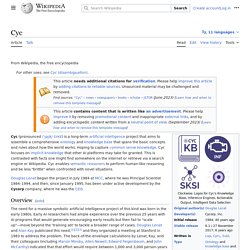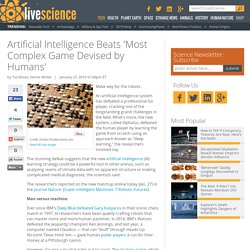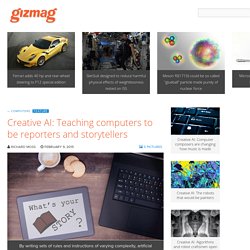

Watch how AI accessing a huge face database can create better restorations. YouTuber bycloud demonstrates how a deep face dictionary network (DFDNet) can be applied to degraded and low-quality images to create better quality facial restorations: "In this video I combined and compared colorization, upscaling, and image super-resolution.

" For those interested in the technical aspects, here is a paper on how it works. This iconic image of Che Guevara gets significantly sharper when processed in black and white: Below is a blurry low-res image of Marilyn Monroe, first AI colorized, then run through DFDNet: Here is the same with Charlie Chaplin: Image: YouTube / bycloud Black smoke ring over Santa Clara This video shows a black smoke ring floating over Santa Clara, California. The Next Big Privacy Hurdle? Teaching AI to Forget.
AI That Evolves in the Wild. The measure of a good story is that it gets better as it’s repeated by other people, such as Danny’s story about the Songs of Eden and how you can look at the development of language and consciousness from the point of the view of the songs themselves, these strings of language.

Artificial Stupidity. Artificial Stupidity by Ali Minai "My colleagues, they study artificial intelligence; me, I study natural stupidity.

" —Amos Tversky, (quoted in “The Undoing Project” by Michael Lewis). Not only is this quote by Tversky amusing, it also offers profound insight into the nature of intelligence – real and artificial. One of America's Spy Agencies Will Test Sentiment Analysis to Help Sniff Out Insider Threats. Cyc. Douglas Lenat began the project in July 1984 at MCC, where he was Principal Scientist 1984–1994, and then, since January 1995, has been under active development by the Cycorp company, where he is the CEO.

Overview[edit] The project began in July 1984 as the flagship project of the 400-person Microelectronics and Computer Technology Corporation (MCC), a research consortium started by two dozen large United States based corporations "to counter a then ominous Japanese effort in AI, the so-called "fifth-generation" project. "[4] The US Government reacted to the Fifth Generation threat by passing the National Cooperative Research Act of 1984, which for the first time allowed US companies to "collude" on long-term high-risk high-payoff research, and MCC and Sematech sprang up to take advantage of that ten-year opportunity.
MCC's first President and CEO was Bobby Ray Inman, former NSA Director and Central Intelligence Agency deputy director. Swarming robot boats demonstrate self-learning. Robots may be the wave of the future, but it will be a pretty chaotic future if they don't learn to work together.

This cooperative approach is known as swarm robotics and in a first in the field, a team of engineers has demonstrated a swarm of intelligent aquatic surface robots that can operate together in a real-world environment. Using "Darwinian" learning, the robots are designed to teach themselves how to cooperate in carrying out a task. A major problem facing the navies of the world is that as ships become more sophisticated they also become much more expensive.
Artificial Intelligence Beats 'Most Complex Game Devised by Humans' Make way for the robots.

An artificial intelligence system has defeated a professional Go player, cracking one of the longstanding grand challenges in the field. What's more, the new system, called AlphaGo, defeated the human player by learning the game from scratch using an approach known as "deep learning," the researchers involved say. The stunning defeat suggests that the new artificial intelligence (AI) learning strategy could be a powerful tool in other arenas, such as analyzing reams of climate data with no apparent structure or making complicated medical diagnoses, the scientists said. The researchers reported on the new matchup online today (Jan. 27) in the journal Nature. What Happens When Computers Learn to Read Books? "Every individual piece of writing is a function of all writing.

" ~ Philosopher Alan Watts In Kurt Vonnegut's classic novel Cat's Cradle, the character Claire Minton has the most fantastic ability; simply by reading the index of the book, she can deduce almost every biographical detail about the author. The Philosophical Importance of Algorithms. Artificial Intelligence: How Algorithms Make Systems Smart. “Algorithm” is a word that one hears used much more frequently than in the past.

One of the reasons is that scientists have learned that computers can learn on their own if given a few simple instructions. Creative AI: Teaching computers to be reporters and storytellers. We humans are obsessed with storytelling.

We tell stories to people we meet and people we love. We can't get enough of the stories that drive movies, video games, television, and books. Data that lives forever is possible: Japan's Hitachi. As Bob Dylan and the Rolling Stones prove, good music lasts a long time; now Japanese hi-tech giant Hitachi says it can last even longer—a few hundred million years at least.

The company on Monday unveiled a method of storing digital information on slivers of quartz glass that can endure extreme temperatures and hostile conditions without degrading, almost forever. And for anyone who updated their LP collection onto CD, only to find they then needed to get it all on MP3, a technology that never needs to change might sound appealing. "The volume of data being created every day is exploding, but in terms of keeping it for later generations, we haven't necessarily improved since the days we inscribed things on stones," Hitachi researcher Kazuyoshi Torii said.
Simulated brain mimics human quirks. The Personality Forge AI - Chat Bot Search. Robot learns ‘self-awareness’ Who’s that good-looking guy? Nico examines itself and its surroundings in the mirror. (Credit: Justin Hart / Yale University ) “Only humans can be self-aware.” Can A Computer Finally Pass For Human? “Why not develop music in ways unknown…? If beauty is present, it is present.” That’s Emily Howell talking – a highly creative computer program written in LISP by U.C. Santa Cruz professor David Cope. (While Cope insists he’s a music professor first, “he manages to leverage his knowledge of computer science into some highly sophisticated AI programming.”) Deep learning.
Branch of machine learning Deep learning (also known as deep structured learning or differential programming) is part of a broader family of machine learning methods based on artificial neural networks with representation learning. Learning can be supervised, semi-supervised or unsupervised.[1][2][3] Deep learning architectures such as deep neural networks, deep belief networks, recurrent neural networks and convolutional neural networks have been applied to fields including computer vision, speech recognition, natural language processing, audio recognition, social network filtering, machine translation, bioinformatics, drug design, medical image analysis, material inspection and board game programs, where they have produced results comparable to and in some cases surpassing human expert performance.[4][5][6] Artificial neural networks (ANNs) were inspired by information processing and distributed communication nodes in biological systems.
Definition[edit] Overview[edit] History[edit] She's Not Talking About It, But Siri Is Plotting World Domination. Photo: Alex Washburn/Wired Apple has a vision of a future in which the disembodied voice of Siri is your constant companion. It goes something like this: You arrive home at the end of a long day and plop down on the couch. A beer in one hand, your phone in the other, you say, “Siri, open Netflix and play The IT Crowd.” Midway through the program, you feel a draft. Honda testing vehicle-to-vehicle communications to eliminate SMIDSY accidents. Top notch AI system about as smart as a four-year-old, lacks commonsense. Harvard scientists develop a transistor that learns.
Human misidentification in Turing tests - Journal of Experimental & Theoretical Artificial Intelligence - Implementing Turing's imitation game as a scientific experiment provides an insight into human–human interaction of the type that can be seen in email communication. F-35 Delayed After Fourth Prototype Becomes Self-Aware And Has To Be Destroyed. THE PENTAGON — The military’s problematic F-35 fighter jet is facing more delays related to “software issues,” as project engineers were forced to euthanize the fourth prototype to gain self-awareness on Monday. According to Air Force Lt. Gen. RoboEarth "Wikipedia for robots" demonstrated.
Graphene-based nano-antennas may enable cooperating smart dust swarms. Smart dust. Do you know whether this press release was written by a human? Printer friendly version Share 14 March 2014 Taylor & Francis. Scientists try to teach robots morality. Eugene Goostman chatbot passes Turing Test. "Tell me Dave" robot learns simply by people talking to it. Robo Brain uses the web to teach robots human knowledge.
Robo Brain. Artificial intelligence program that learns like a child.